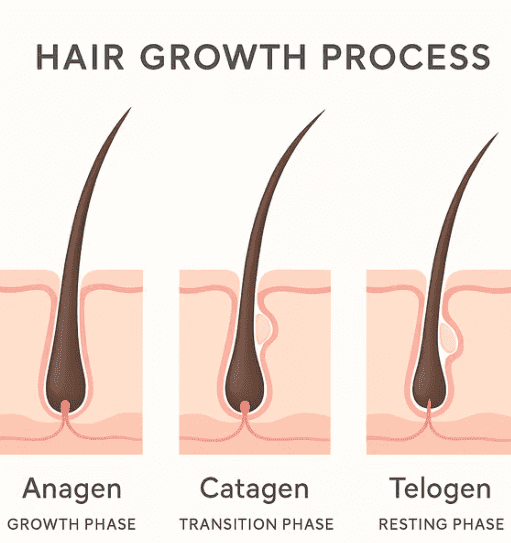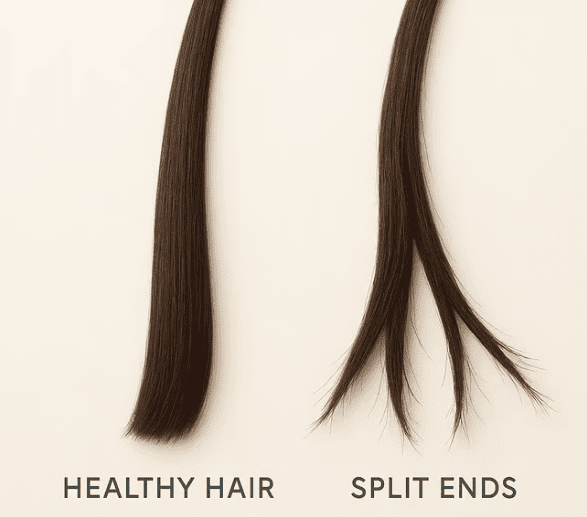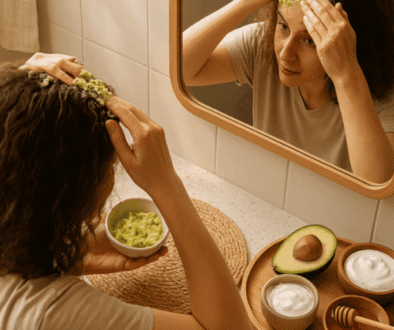Does Split End Slow Hair Growth?
True Nature Care 🌿 Home Remedies & DIY, 💇♀️ Hair care routines & remedies 1
Table of Contents
ToggleLet’s Dive into the Truth about Split Ends and Hair Growth
Hair growth is a widely discussed topic, especially among individuals looking to achieve longer, healthier hair. A common belief floating around is that split ends can slow down hair growth. Many people make it a habit to trim their hair regularly, thinking that cutting off those split ends will help their hair grow faster. But is there any truth to the idea that split ends actually hinder hair growth, or is it just a myth?
To answer this question, we must first understand how hair grows. Hair grows from the follicles in your scalp, not from the tips. The American Academy of Dermatology (AAD) states that hair typically grows about half an inch each month, regardless of whether the ends are split. While split ends don’t directly slow down hair growth, they can affect the overall health of your hair, leading to breakage and thinning.
How Hair Grows?
To really grasp whether split ends impact hair growth, it’s crucial to know the hair growth process. Hair grows from the follicles in the scalp, not from the ends. According to the American Academy of Dermatology (AAD), hair grows at an average rate of about half an inch per month, no matter if the ends are split or not. Each hair strand goes through a growth cycle that consists of three phase.
1. Anagen Phase: This is the active growth phase, lasting anywhere from 2 to 7 years.
2. Catagen Phase: A brief transitional phase where hair growth slows down.
3. Telogen Phase: The resting phase, during which old hair falls out and new hair starts to grow.
So, does this mean you can just ignore split ends? Definitely not! Ignoring them can lead to serious hair damage, making it look like your hair isn’t growing at all. Let’s take a closer look at how they can affect the appearance of hair growth, and what steps you can take to prevent them.

The Impact of Split Ends on Hair Growth
While split ends don’t actually slow down the rate of hair growth, they can definitely give the impression that your hair isn’t growing at all. Here’s why:
• Breakage: When your hair gets dry and brittle, those split ends can cause it to break off, making it tough to keep your length.
• Thinning: Split ends weaken the hair shaft, which can make your hair look thinner and more vulnerable to damage.
• Tangled Hair: With split ends, your hair is more likely to tangle, leading to even more breakage when you brush or style it.
So, even though split ends don’t impact the growth happening at the roots, they can keep you from seeing that length and thickness you’re hoping for over time.
Signs You Have Split Ends
Curious if you’ve got split ends? Here are some common signs:
• The ends of your hair look frayed, rough, or uneven.
• Your hair tangles easily and feels less smooth.
• Hair looks dry and brittle, especially at the tips.
• You spot small, split-like breaks when you take a closer look at the ends.
The Hidden Damage Caused by Split Ends
What Are Split Ends and Why Do They Form?
Split ends, scientifically known as trichoptilosis, happen when the protective outer layer of your hair, known as the cuticle, gets damaged. Once that cuticle is compromised, the inner layers of the hair shaft are left exposed, leading to fraying or splitting of the hair strand.

There are several culprits behind split ends:
1. Heat Styling: Overusing heat tools like straighteners, curling irons, and blow dryers can weaken the hair shaft, causing it to break apart.
2. Chemical Treatments: Hair dye, bleach, and relaxers can change the structure of your hair, making it more prone to splitting.
3. Over washing: Washing your hair too often with harsh shampoos strips away natural oils, leaving it dry and brittle.
4. Friction: Rubbing your hair with a rough towel, wearing tight hairstyles, or sleeping on cotton pillowcases can create mechanical stress, leading to split ends.
5. Lack of Moisture: Dry hair is more vulnerable to breakage. Lack of proper hydration and conditioning accelerates split-end formation.
6. Environmental Factors: Sun exposure, pollution, and harsh weather conditions can weaken hair fibers, contributing to split ends.
Why Split Ends Make Hair Seem Shorter
Split ends can trick us into thinking our hair isn’t growing. When the ends get damaged, they become weaker and are more likely to break off. So, even though new hair is sprouting from the scalp, the length at the ends doesn’t really change because of all that breakage.
A study published in the International Journal of Trichology found that people with untreated split ends noticed a significant decrease in both hair thickness and length over time. This happens because those damaged strands break off faster than new hair can grow, creating the illusion that our hair is growing slowly or not at all.
On top of that, split ends can make hair look frizzy and messy, giving it an unhealthy and shorter appearance. The more split ends you have, the more they can travel up the hair shaft, leading to even more breakage and thinning. That’s why getting regular trims is key to keeping your hair looking healthy and longer.
How to Prevent and Manage Split Ends for Healthy Hair Growth
1. Regular Trimming (But Not Too Often)
While cutting off split ends won’t make your hair grow faster, it does help prevent further breakage, allowing your hair to keep its length. Experts suggest trimming your hair every 8–12 weeks to get rid of split ends and maintain a healthy look. Just be careful not to over-trim, as that can slow down your growth goals. Finding the right balance is essential.
2. Use the Right Hair Care Products
• Sulfate-Free Shampoo: Harsh detergents can strip away natural oils and dry out your hair, leading to more breakage.
• Deep Conditioning Treatments: Using a deep conditioner or hair mask once a week can keep your hair hydrated and help reduce splitting.
• Leave-In Conditioners & Serums: Look for products with keratin, argan oil, or shea butter, as they help strengthen the hair shaft and lock in moisture.
3. Minimize Heat and Chemical Damage
• Use Heat Protectant: If you’re going to use heat styling tools, always spritz on a heat protectant spray first to help shield your hair from damage.
• Reduce Heat Styling Frequency: Whenever you can, let your hair air-dry instead of reaching for the blow dryer.
• Space out Chemical Treatments: Try to avoid overdoing it with bleaching, perming, or relaxing your hair, as these processes can really weaken its structure.
4. Adopt Gentle Hair Handling Techniques
• Use a Wide-Tooth Comb: Be gentle when detangling your hair to avoid causing any mechanical damage.
• Avoid Brushing Wet Hair: Your hair is more delicate when it’s wet, making it easier to break.
• Use a Microfiber Towel or T-Shirt to Dry Hair: These options are much kinder to your hair than regular towels.
5. Protect Hair from Environmental Damage
• Wear a Hat or Scarf: Keep your hair safe from harsh sun exposure by covering it up.
• Rinse Hair after Swimming: Chlorine and saltwater can really take a toll on your hair, so give it a good rinse afterward.
6. Maintain a Healthy Diet
Your hair’s health is closely tied to what you eat. Research published in the Journal of Cosmetic Dermatology shows that lacking iron, biotin, and protein can lead to weak, brittle hair. Make sure your diet includes:
• Protein (thin lean meats, eggs, and nuts)
• Omega-3 fatty acids (like salmon and flaxseeds)
• Vitamins A, C, D, and E (found in fruits, veggies, and nuts)
• Biotin and Iron (from leafy greens, beans, and whole grains)
Also Check out Best Fruits to Promote Hair Growth and its importance in our hair growth.
7. Use Protective Hairstyles
Steer clear of tight hairstyles that put stress on your hair strands. Opt for protective styles like braids, buns, or twists to help reduce mechanical damage.
Maintaining Healthy Hair Growth
Taking care of your hair growth starts with understanding how split ends can affect its overall health. While split ends don’t actually stop your hair from growing, they can make it appear shorter. To promote healthy growth, it’s essential to pay attention to both the roots and the ends of your hair.
Healthy hair care involves nurturing the roots while also protecting the ends. This balanced approach not only helps prevent damage but also encourages natural growth. It’s all about keeping your hair in great shape from top to bottom.
Long-term hair care requires a bit of patience and consistent effort. Regular trims, being gentle when you detangle, and opting for protective styles are all key practices. Keeping your scalp moisturized and steering clear of excessive heat can help your hair stay strong and vibrant.
It’s perfectly normal for some split ends to occur over time. However, knowing how to manage them can make a difference. This mindset allows you to set realistic expectations for your hair growth journey.
By following these tips, you can achieve healthier, longer hair. Sticking to proven methods ensures your hair remains in good condition without sacrificing quality. Remember, small, consistent actions can lead to significant changes over time. So, kick start your journey to thicker, longer hair today by making smart choices in your care routine. Also check out The best natural hair care routine to boost growth and shine.
FAQ
Does having split ends affect hair growth?
Split ends don’t hinder hair growth at the follicle level. On average, hair grows about half an inch each month. However, if split ends are left untreated, they can lead to breakage, making it seem like your hair isn’t growing.
What causes split ends in hair?
Split ends are primarily caused by physical damage, which can result from heat styling, chemical treatments, and UV exposure. Additionally, environmental factors and improper brushing techniques can contribute to hair damage, leading to split ends.
How can I identify split ends?
You can spot split ends by looking for single splits or splits that resemble tree branches. You might also notice white dots where the hair has broken. Split ends can make your hair feel rough when you run your fingers through it.
Are there effective treatments for split ends?
The only guaranteed way to tackle split ends is to get a trim. However, there are products that can help improve their appearance. These include bond-building treatments, protein-infused products, and nourishing hair oils. They work wonders in keeping your hair looking healthy and preventing further damage.
How can I prevent split ends?
To prevent split ends, make sure to wash your hair properly and condition it thoroughly. Try to minimize heat styling and wear protective hairstyles. Plus, eating a balanced diet rich in nutrients can help strengthen your hair.
When should I seek professional help for split ends?
If you notice your hair is breaking frequently despite your best home care efforts, or if you see unusual splitting patterns, it’s time to consult a stylist. They can provide more than just a trim if needed.
What are the psychological effects of having split ends?
Having split ends and damaged hair can take a toll on your self-esteem and confidence. It can influence how you perceive yourself and your grooming habits. Taking good care of your hair can significantly boost your emotional well-being.




Natural Hair Care Routine for Faster Growth & Shine
May 14, 2025 @ 1:45 pm
[…] Also Read Our Blog on Does Split end slow hair growth? […]